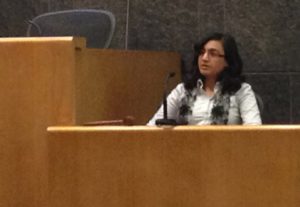Penn State Health and Penn State Law partner for interdisciplinary course

Allen Neely was surprised to learn throughout his 25 years of practicing law that most physicians aren’t exposed to the legal system during their education and training.
According to Neely, an adjunct professor at Penn State Law, the courtroom is a new and intimidating environment for those who practice medicine. He often wondered if just a basic exposure to the legal system would benefit doctors, who may be called into court as a witness or defendant at some point in their careers.
Neely didn’t realize that someone else was also thinking along the same line.
Dr. Joseph Wiedemer, director of the Penn State Health Family and Community Medicine residency at Mount Nittany Medical Center in State College, Pa., wondered how he could introduce young physicians to the legal system and help them understand how it might enhance their practice of medicine.
Wiedemer said that when developing a new residency program, it’s important to look for opportunities in the community to give your residents unique learning experiences. He realized that Penn State Law, just minutes down the road from Mount Nittany Medical Center, provided a perfect opportunity for collaboration.
“Engaging with the University was one of our five missions in creating this program,” Wiedemer said. “I hoped that by interacting with each other, law students and medical residents might gain a better appreciation for the challenges each other face. I wanted both professions to understand how they could learn from each other.”
Building a course from scratch
So Wiedemer pitched the idea of an interdisciplinary course where Family and Community Medicine residents and students from Penn State Law would learn from each other. Wiedemer teamed up with Neely, and the two began to create a curriculum for the course.
There was only one challenge – to their knowledge, few institutions had offered a course like this before.
That didn’t stop Neely and Wiedemer from developing a syllabus that consisted of a mock trial, a visit to a cadaver lab and testimonies from physicians who had experience in the courtroom.
Although Neely and Wiedemer gave structure to the course, they allowed the residents and law students to teach each other and drive classroom discussion. Ultimately, they wanted each group of students to be able to appreciate the complexity of each other’s jobs.
“My hope was that the fear, anxiety and stress experienced by both professions when encountering each other would be decreased through education and understanding,” Wiedemer said.
Unique learning experiences
Dr. Vish Patel, a resident who participated in the class, gained new insight by hearing firsthand from two physicians who shared their legal experiences with the class. He said that listening to those testimonies helped him understand the challenges physicians face in court.
“I had read about legal cases involving medicine,” Patel said. “To be able to discuss the process with physicians who had those experiences put it into perspective for me.”
Patel and his fellow residents had the opportunity to teach the law students about their profession through a series of anatomy lessons, which included a trip to the cadaver lab. He said the demonstrations gave the law students a new appreciation for how complex a physician’s job is.
“It was an eye-opening experience for the law students,” Patel said. “Even the students who were uncomfortable around the cadavers walked away with new knowledge and a newfound respect for what physicians deal with daily.”
Called to the stand
The course culminated in a mock trial, which was based on a real-life malpractice suit. Neely served as judge, while the residents played the medical roles and the law students played the attorneys. The residents met with the law students for weeks before the final hearing to prepare their statements.
During those weeks of preparation, Wiedemer said the residents were able to understand that the law students face pressures just like the residents do. Understanding the responsibilities of lawyers prepared the residents to experience a court room setting.
“They got to be on the stand and get questioned,” Wiedemer said. “They got to experience what it felt like to walk up, be sworn in and asked about a medical case where they had to place themselves in another physician’s shoes.”
Wiedemer and Neely agreed the course was a success. Penn State Law has invited them to instruct it again in Spring 2020. Next time, Wiedemer hopes to get medical students and faculty from Penn State College of Medicine involved, since the legal aspects of medicine are often absent in a packed medical school curriculum.
Ultimately, Patel believed he got exactly what he wanted to out of taking the course – a better understanding.
“I knew very little, if anything, about the legal side of medicine before taking the course,” Patel said. “I enjoyed learning from the law students and feel I gained new insight into the legal aspects of medicine.”
If you're having trouble accessing this content, or would like it in another format, please email Penn State Health Marketing & Communications.


